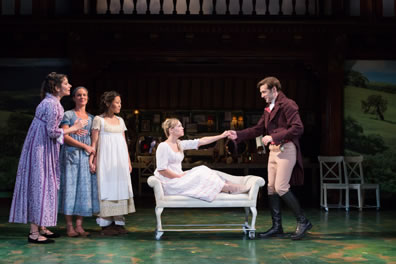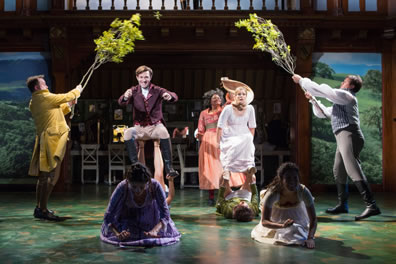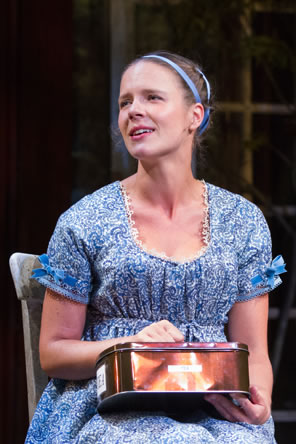Sense and Sensibility
Emotions in Motion
Written by Jane Austen, Adapted by Kate Hamill
Folger Theatre, Washington, D.C.
Sunday, September 18, 2016, E–10&12 (right stalls)
Directed by Eric Tucker

The Dashwoods—from left, Mrs. Dashwood (Lisa Birnbaum), Elinor (Maggie McDowell), Margaret (Nicole Kang), and, sitting with injured ankle, Marianne (Erin Weaver)—meet Willoughby (Jacob Fishel) in the Bedlam production of Sense and Sensibility at the Folger Theatre. Photo by Teresa Wood, Folger Theatre.
Bedlam can't seem to shake Sense and Sensibility. Bedlam, director and actor Eric Tucker's New York–based theater company, first staged Kate Hamill's adaptation of Jane Austen's 1811 novel in 2014 in a New York black-box theater with 10 actors. Tucker is known for his creative boldness in staging plays, and Bedlam's productions always earn great critical acclaim, but it was simply the public popularity of Sense and Sensibility that led to its revival. Then another revival, and that one, extended again and again, is finally set to end its run at New York's Gym at Judson on Nov. 20 (if it doesn't get extended again).
We've seen Bedlam's four-actor Hamlet and Saint Joan and five-actor Twelfth Night and What You Will (those last two different productions playing in repertory), but as much as we love Bedlam's work, we never got the chance to see Sense and Sensibility in New York. Thankfully, it came to us in Washington, D.C., with a new cast at the Folger Theatre. What a theatrical gift it is for the people of the Capital Region. And, yes, its run at the Folger has been extended, too. Twice, now concluding on Nov. 13.
This production is an absolute delight on many levels.
First, there's Austen. Her tale of the suddenly widowed Mrs. Dashwood's three daughters navigating early 19th century English upper-crust society and its strict conventions in courtship and matrimony is a gripping romance with many twists and turns. Austen populates her story with a host of singularly engaging characters, and her own wisdom shines through in her characters' wits and ways. There's also a bit of Shakespeare. Not only was Austen influenced by Shakespeare, his works show up often in Sense and Sensibility. When this production opened, Folger's Great Hall adjacent to the theater housed an exhibit comparing the “Cult of Celebrity” of Shakespeare and Austen.
Then there's Hamill. Her adaptation of Austen's novel glides along at an easy pace while maintaining the emotional depth required for us to take such a keen interest in the Dashwoods, to care about the conflicted Edward Ferrars, to come to trust Colonel Brandon, and to distrust John Willoughby. Hamill also cleverly creates an aural landscape of gossip. The ensemble fills in narrative details in the manner of excited chatter and also occasionally creates a sustained buzz comprised of scripted lines spoken simultaneously. If you could concentrate in these moments on each individual's lines, you'd realize they intertwine into a constant thematic current that advances the story, like a series of whitewater rapids in an otherwise gently flowing stream.
And certainly, there's Tucker. He is one of the most innovative theater directors in the business, busting through any and all conventions in staging plays. From rearranging audiences over the course of a play to maximizing the fluidity of his casts (e.g., effectively presenting Hamlet's and Twelfth Night's climactic fifth acts with just four or five actors, respectively), he redefines traditional live theater. Genius stumbles occasionally, but with Sense and Sensibility Tucker makes nothing but right choices.
One of his key creative contributions is, simply, putting the set, designed by John McDermott, on wheels: chairs, settee, tables, potted plants, conservatory windows. The action never pauses from scene to scene, and rolling furniture expedites set changes: sometimes characters arrive on a spot and sit down at the exact moment their chair arrives, even as they are confidently delivering their lines. The wheeled set also has thematic resonance: sometimes the characters are spinning out of control, other times their world is spinning out of control. Another thing Tucker does—just as Hamill uses the cast to provide her play's aural environment—is use the cast to create the play's physical environment, supplementing the furniture (in one bedroom scene, actors supply the blankets or serve as bed stands), outfitting a carriage (providing the seats and horses), or, like puppeteers, creating the weather (a wind gentle enough to brush the branches or strong enough to make Marianne's scarf flap after her).
All of this is done with a bit of a fourth-wall-evaporating attitude that bonds ensemble and audience in one experience. When Willoughby (Jacob Fishel) first arrives on the scene carrying Marianne Dashwood (Erin Weaver) after she's fallen in the rain and hurt her ankle, he enters in a shower of mist (two servants with spray bottles) and poses as a man who knows he's a matinee idol. He can't stay, he protests, because "my pointers are outside," and the two misters point at him. This somehow doesn't come off as hammy because of what most makes this production an absolute delight: the actors.

Willoughby and Marianne Dashwood (Jacob Fishel and Erin Weaver, center) go for a wind-swept ride in Bedlam's production of Jane Austen's Sense & Sensibility at the Folger Theatre as other members of the cast serve as the carriage (Maggie McDowell and Kathryn Tkel), the horses (Lisa Birnbaum and Nicole Kang), passing trees (Michael Glenn and Jamie Smithson), and the wind (Caroline Stefanie Clay) whipping at Marianne's scarf. Photo by Teresa Wood, Folger Theatre
From playing a horse tethered to someone in the audience to portraying a flighty teen and ancient dowager simultaneously, this cast comprises 10 remarkably talented individuals whom Tucker has molded into a tight ensemble with the impeccable timing and coordination necessary for the play's intellectual and physical fluidity (I wonder if, rather than fight calls, this cast has furniture-moving calls).
This is best exemplified in The Party scene at the Ferrars's London home. Hamill's original script suggests that the ultraelderly, ill-tempered Mrs. Ferrars could be played by a “nasty puppet” held by her snobbish daughter, Fanny Dashwood (Kathryn Tkel). With a 10-actor cast requiring doubling roles, Tkel already is playing the young Lucy Steele, Elinor Dashwood's rival for the affections of Edward, and both women are at the party to be presented to the ancient Mrs. Ferrars. So, Tucker doubles down on the doubling in this scene by having Lisa Birnbaum, playing Lucy's wide-eyed, airhead sister, Anne, also playing Mrs. Ferrars. Tkel and Birnbaum as the two young Steele sisters sit on one side of the stage, and when their cue comes to portray the two older Ferrars women, cast members shove Tkel's and Birnbaum's chairs whirling across the stage to counterparts catching them on the opposite side. In that two-second transport, Tkel has transitioned from smarmy, naive Lucy to primly obnoxious Fanny, and Birnbaum goes from a head-held-high Tweety Bird to a crumpled, barely understandable Grendel. After both speak (or screech) their lines, they are sent spinning back across the stage to register the two young sisters' reactions, a cycle repeated again later in the scene. It is an awesome theatrical moment.
When she's not Tweety or Grendel, Birnbaum is playing Mrs. Dashwood, her quiet, dignified bearing enveloping a warm-hearted, life-reveling soul. Birnbaum creates 4D renderings of three characters of three distinctive dimensions. Fishel similarly brings an enticing charm to the obviously arrogant Willoughby while dipping his naturally genial John Dashwood (the three sisters' elder half brother) in a vat of privileged snobbery stirred by his wife, Fanny. By contrast, Jamie Smithson doesn't alter his voice, gestures, posture, or even his portrayal much when he switches from the socially awkward, slightly clumsy but huge-hearted Edward Ferrars to his rude, carelessly entitled, drunk brother, Robert. Having ourselves fallen in love with Smithson's Edward over the first three-quarters of the play and so yearning for him to hook up with Elinor (Maggie McDowell), Smithson's Edward suddenly appearing as the scoundrel Robert is a hilarious shock. He provides a laugh-a-minute Don Rickles routine insulting everyone in his peripheral vision, whether they be other characters he suddenly notices are standing right next to him or people he glimpses in the audience.
All of these characters revolve around the three Dashwood daughters—my math is good, here, for it's not just the two elder girls, McDowell's Elinor and Weaver's Marianne, but Nicole Kang's Margaret, too. Kang does great work portraying an impulsively petulant, endearing brat of a kid. Every youngest sibling feels her pain, while every older sibling sees her as a pain. Weaver's Marianne is a lightning rod of rambunctiously emotional energy. She wears her every feeling on her sheer sleeve. A feminist spirit and force of personality, qualities that so attract both the fun-loving Willoughby and the stiffly serious Colonel Brandon (James Patrick Nelson), this Marianne has as her only obstacle her own reckless immaturity.

Maggie McDowell as Elinor Dashwood in Bedlam's Sense & Sensibility at the Folger Theatre. Photo by Teresa Wood, Folger Theatre
The production's emotional core, however, is Elinor, a young woman of heroic reserve, given that her heart overflows with yearning. McDowell gives a fascinatingly rich performance, bottling up a Disney World's worth of emotional fireworks inside Elinor's precisely presented public persona. Her courage to keep a tight rein on her own imploding feelings even as she endures the slings and slights of unexpected misfortune captures our hearts. And Edward's heart, too, from first to last—he just doesn't realize how much until his own “misfortune” sets him free.
Though the Folger stage is officially of the proscenium genus, Tucker does as much as he can to erase any sense of a fourth wall in the play space. When the actors are playing the Gossips, they sometimes are placed throughout the theater so that we get a surround-sound sense of the chattering hordes. Actors use direct address to patrons, particularly Smithson as the scoundrel George and all of them as the Gossips. When Edward leads his horse, played by Michael Glenn (not wearing any sort of Bottom-like head, just his 19th century costume, the work of Designer Mariah Hale), down the theater's center aisle and mimes tying him to one of the seats, Glenn's horse gazes indifferently at a row of people until one woman reaches up and scratches behind his ears. She can't help herself, Glenn's such a sweet-demeanored equine, and like any horse he appreciates the scratch.
This isn't method acting (Glenn otherwise portrays the gregarious Sir John Middleton opposite the equally effusive Caroline Stefanie Clay as Mrs. Jennings): this is barrier-free theater, actors and audience sharing in the mutual fun.
“Austen's stories resonate with us today because not all that much has really changed about people,” Tucker writes in his program notes, opining that Austen today would have embraced the worlds of Facebook, Twitter, and other social digital media. “We love gossip and intrigue and celebrity. We fall in love with people we can't have and people we shouldn't have and people our parents hate. We find love and lose love and talk about love and dream about love and obsess about love. … Jane Austen was writing about all of us for all time.” Most important, of course, was how well she wrote about us, Tucker comparing her to Shakespeare. “She's insightful and funny and deliciously witty and edgier than we remembered, and in spite of never finding love herself she managed to write one of the best endings since Shakespeare's Twelfth Night.”
In temperament, Tucker is all that, too—“if she were alive, we'd totally be Facebook friends,” he writes—and he has the skills to make Shakespeare's ending for Twelfth Night resonate with an audience as well as Shakespeare could have hoped. Austen is in good hands. “I think that if Jane Austen had written plays, they'd sound like this one,” Tucker writes. That's high praise for Hamill, too—higher praise for Austen.
Eric Minton
October 24, 2016
Comment: e-mail editorial@shakespeareances.com
Start a discussion in the Bardroom



 Find additional Shakespeareances
Find additional Shakespeareances